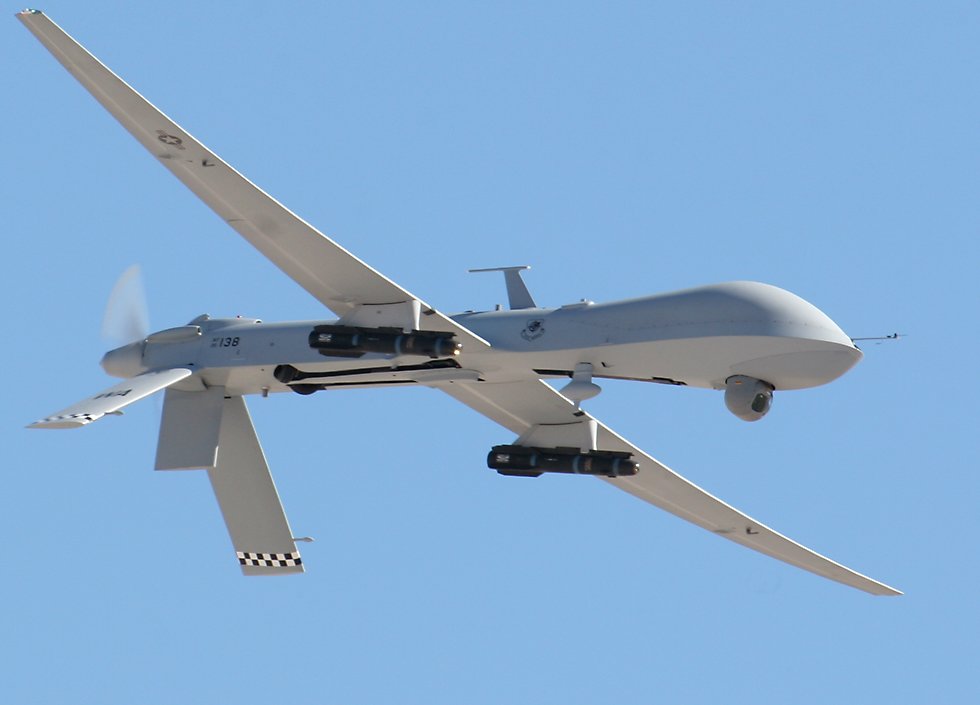The War on Terror rolls on today in 2014 after 13 years of warfare. Through these 13 years, the technology of war has advanced as the United States’ government has pushed a large budget towards the defense industry which has taken the money to improve its capabilities in defending the United States against terrorist networks such as Al-Qaeda and its affiliates (Al-Shabab, Abu Sayaaf, Somali and Filipino branches of Al Qaeda respectively). One of these military technological developments is the development of various multipurpose flying drones. These drones can take photographs of targets, laser target objectives for laser-guided munitions from other aircraft, and even with later developments to the technology, the drone itself could carry and deliver lethal munitions with precise accuracy to the target.

An Air Force MQ-1 Predator Unmanned Aerial Vehicle (UAV or A.K.A. a drone) The Predator drone shown here has been armed with Hellfire air to surface missiles.
The Air Force has grown incredibly reliant on drones to complete missions, and the reason why the debate on drones has been started is the government has begun to use drones over countries that are not in conflict with the United States, but are known to hold terrorist strongholds. Examples include, Somalia, Libya, Algeria, Yemen, Pakistan, North Korea and Iran. The drones over these countries spy and even sometimes destroy high value targets that are in the sovereign territory of these nations even though the United States is not at war with these countries. The debate about this drone policy is the use of these drones can be seen as an act of war, and is what many would consider as technically illegal in the eyes of international law as the United States many times does not ask for the country’s permission in using these lethal spy drones over the country’s sovereign airspace to photograph the area or to engage a high value target that may be in the area.
Another facet of the debate over the legality of drones is there are many cases of drones initiating a missile strike and the destruction causes excessive collateral damage, because targets often live among villages or other areas of high terrorist activity. These innocent casualties are the face that the countries that we infiltrate with our drones use as news fodder to promote hatred against the United States’ policies and as a face to their objection to the ignoring of their sovereign airspace by the United States and its military. Pakistan in particular is extremely agitated by the activity of American drones over its western tribal lands. As much as the Pakistani government desires to degrade the Taliban base of operations in this western frontier of sorts for Pakistan, the Pakistani government would still desire to take care of the threat itself, not with any American aid, especially when this aid is given without asking.
The debate also is a hot area also for some Americans, because the government has ruled that in the interest of national security, the government has the legal right to eliminate an American who is deemed as a threat (terrorism related or not). This angered many (rightfully so in my opinion) and invoked thoughts to many of a 1984 Orwellian “Big Brother is watching” scenario of where the government could eliminate any American as a target whenever the government would decide to eliminate them.
Although these are the arguments against the American policy of drone use, many, including some citizens of the countries that are being infiltrated by these drones, are approving of the CIA and Air Force’s use of drones. For example, in the tribal lands of Pakistan that I have mentioned earlier in this post, several surveys have shown that many approve of the drone strikes and would prefer more drones in the skies above them. They find the laser guided missile strikes much more effective than the artillery barrages of the Pakistani military’s effort to drive out the terrorist forces from the area. Opposite of mainstream Pakistani opinion, many of those who live in the tribal lands believe that the drone strikes do not kill many civilians in unfortunate collateral damage.

The Federally Administered Tribal Area (FATA) is the largest base of operations for the Taliban and Al Qaeda forces that plague Afghanistan as well as other places around the world.
The pros and cons of drone warfare and drone surveillance are both valid in their own ways, and it would be difficult to come to a conclusion on which side is more right. I believe that the use of drones is vindicated, but it is up to the public to be mindful and wary of the government abusing its “toys” to eliminate targets which don’t even benefit the War on Terror anymore, but are just used as the President’s flying, robotic, stealth assassins. As with many things in this great country, it is up to the people to be wary of the government’s doings, and to police them with the voice of the people.

